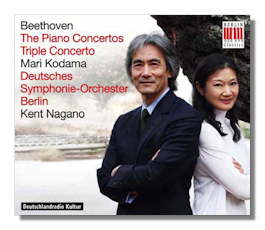
The Internet's Premier Classical Music Source
Related Links
- Beethoven Reviews
- Latest Reviews
- More Reviews
-
By Composer
-
Collections
DVD & Blu-ray
Books
Concert Reviews
Articles/Interviews
Software
Audio
Search Amazon
Recommended Links
Site News
 CD Review
CD Review
Ludwig van Beethoven

- Piano Concerto #1 in C major, Op. 15
- Piano Concerto #2 in B Flat Major, Op. 19
- Piano Concerto #3 in C minor, Op. 37
- Piano Concerto #4 in G Major, Op. 58
- Piano Concerto #5 in E Flat Major "Emperor", Op. 73
- Concerto for Piano, Violin & Cello in C Major, Op. 56 *
Mari Kodama, piano
* Kolja Blacher, violin
* Johannes Moser, cello
Deutsches Symphonie-Orchester Berlin/Kent Nagano
Berlin Classics 0300597BC 3CDs 67:40+70:07+73:18
On the whole, I find myself less impressed by these performances than my colleague Robert Cummings; we tend to review the same issues and I always appreciate his differences of opinion. Read his work, too (Berlin Classics 0300597BC). At any rate, the apparent purpose of this set is to show Beethoven's "lighter" side. Classical music loves a gimmick. The truth is, Beethoven was a difficult, crass and occasionally suicidal man; his lighter side is almost exclusively in his art, and doesn't really need to be searched for at this late date. Mind you, "light" Beethoven can be wonderful. Not all of his music has to be drenched in tragedy and despair. Still, a set so intent on finding the happier side of the composer is bound to miss some of the dramatic power that is simply part of the Beethoven experience, and that's what happens here.
On the plus side, this "Triple" Concerto is mostly wonderful, it stays relaxed and doesn't bog down under any unnecessary weight. You can play this work two ways. Either you take the grand and glacial approach (Karajan, EMI), or you go light and crisp (Zinman, Arte Nova/Sony/Brilliant Classics). Much as I admire Karajan's classic EMI account (to say nothing of his dream-team soloists), Zinman and now Nagano have proved that in most cases, lighter is better. On the other hand, the early concertos are reasonably breezy, but they lack sparkle. Mari Kodama has all the notes, but husband and conductor Nagano is less fun. The Berlin orchestra certainly knows what to do, but they add to the overall impression of seriousness in a less than positive way. Kodama's occasionally clipped phrases sound like she's trying to find a playfulness in the music that's already there. She and her husband don't strike me as being especially in sync, as Kodama seems more period-influenced and Nagano remains rather traditional. A different orchestra might have made a difference; German orchestras aren't known for their playful nature.
In the later concertos this interpretative disagreement becomes more pronounced. Kent Nagano's recently completed Beethoven cycle had quirky subtitles and subtext as well, though I couldn't get it from either the U.S. (Sony Classical) or Canada (Analekta). My point is that the conductor knows what he's doing, and is no stranger to the drama and mythos of Beethoven. The problem is that he's seemingly more focused on this than his wife, who really does play very well. The Fourth Concerto has a bright and playful sound that will interest listeners accustomed to the weight of Arrau or the pure poetry of Perahia. Both pianists (Davis for Arrau, Haitink for Perahia) had more sympathetic podium support, and yes, I'm aware that could read "Haitink for Arrau and Perahia". I'm simply not convinced husband and wife are on the same page. Sample the second movement of the same concerto; Kodama plays with a light tenderness that is lovely, even moving. Nagano's somewhat sluggish backdrop is at odds with this, never mind that other conductors bring much more incisiveness to the string playing. The concluding Rondo falls flat. The orchestral playing lacks both sparkle and panache. Kodama also proves too relaxed in places for my tastes, though it does indeed sound different and suits the sets' intentions well.
Finally, the set concludes with a decent "Emperor" Concerto. As Mr. Cummings pointed out, the first movement has a limited ability to be different in terms of overall timings; Kodama is just a touch on the slower side. Unfortunately – or fortunately, depending on your view – this does not translate into anything notable or special. I don't believe every performance has to be different for its own sake, but with a work like this, you ought to try to stand out. The Berlin forces do have a robust brass sound, as Mr. Cummings noted, but I find the strings less than fully engaged, and certainly I've heard more individual winds. Again, there are details brought out that I can appreciate, even value as new insights. But the set remains for me a curiously uneven affair that promises more than it delivers. Still, seasoned collectors will doubtless be as stimulated as Mr. Cummings and I, even if (in my case) we aren't totally convinced.
Copyright © 2015, Brian Wigman





















